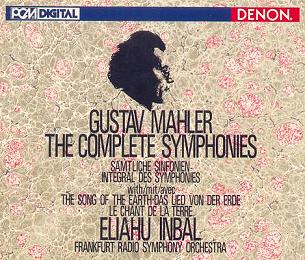 |
|||
|

|
|
Mahler's music often strikes me as being like a Bible, like a catalogue of human feelings, problems, experiences, and characters; it is so all-embracing that it can almost be considered as a voice from the heavens. 
For me, Mahler's symphonies are a unity, one gigantic symphony in eleven movements, better still a single great novel with eleven chapters, consisting of the ten symphonies and "Das Lied von der Erde" (The Song of the Earth). Everything in this novel is interrelated and is only comprehensible (and indeed can only be correctly interpreted) within the context of the whole. For example, the Eighth Symphony can only be properly understood in connection with the Ninth Symphony and "Das Lied von der Erde". The Eighth Symphony could only have come before "Das Lied von der Erde" and the Ninth Symphony, just as a dying person experiences a moment of euphoria shortly before death. For the Eighth only has the appearance of celebration, happiness, and universal peace. With the benefit of hindsight, one feels something forced in this celebration with its illusory optimism. It represents a flight into the grandiose; the screaming, doubting, searching Mahler is as present here as ever. This is especially clear if one looks at the chapters of the novel which follow on from the Eighth. The Eighth Symphony is inextricably linked to the origins of the Ninth, with its luminosity and readiness to face death. One must be prepared to accept in Mahler the unpleasant and the banal as elements of aesthetic expression and induce these elements from the Orchestra. Orchestral musicians often tend to prettify the music on the basis of a specific understanding of musical culture. This approach is not justifiable even in the case of a composer such as Mozart. For example, the woodwinds and the horns in particular tend to play staccatos in a prettified manner; instead of playing them abruptly they soften them, on the grounds that they wish to play in a more musical, more cultivated, more elegant manner. This may well often be the correct approach, but sometimes the conductor must demand the unpleasant, the clear, the fanatic, the hateful, as aesthetic elements even in performances of Mozart or Beethoven, not to mention Mahler. A conductor can only interpret Mahler's music in a manner faithful to the score if he portrays it as torn asunder, always struggling within itself. Elements constantly war against one another in Mahler; where there is beauty there is also ugliness, and one must often be very careful to bring out this struggle with sufficient clarity. The constant lacerations in Mahler require a specific type of interpreter, one who either himself has these lacerations within him (as do so many artists) or for whom they strike a resonance through the circumstances of his own life. Such an interpreter will inevitably bring out these contradictory elements. In Mahler's music these lacerations serve as both breaks and links. I am certain that we have reached an understanding of Mahler's music only since the end of the Second World War. I mean this not in respect to the "technical" aspect of the music, nor to any of the similarities with contemporary music, but rather in connection with the global understanding which underlies the music. A catastrophe such as that in the Finale of the Sixth Symphony is only comprehensible after Hiroshima and Auschwitz. My aim in the interpretation was, within the solid symphonic structure which should under no circumstances be destroyed, to allow the oppositions and extremes in this music their full developmental possibilities, and to bring out the typical Mahlerian orchestral coloring, i.e. folkloric influences, as a third element. In order to achieve the interpretational consequences and the unity of the symphonic works of Mahler, I found it necessary to realize the cycle chronologically and in a brief space of time in the same hall (the superbly sounding Alte Oper in Erankfurt), before the same public, and above all with the same orchestra, an orchestra which has attained the deepest familiarity with Mahler's musical language after many years of continuous work. Mahler's symphonies are excitingly close to our contemporary life and reality. We are aware of this more than we were ten years ago. Mahler is the modern composer par excellence. His music mirrors almost all our current hopes and anxieties, and this it does for many, many people. Eliahu Inbal Translated from German by Robin Thompson |